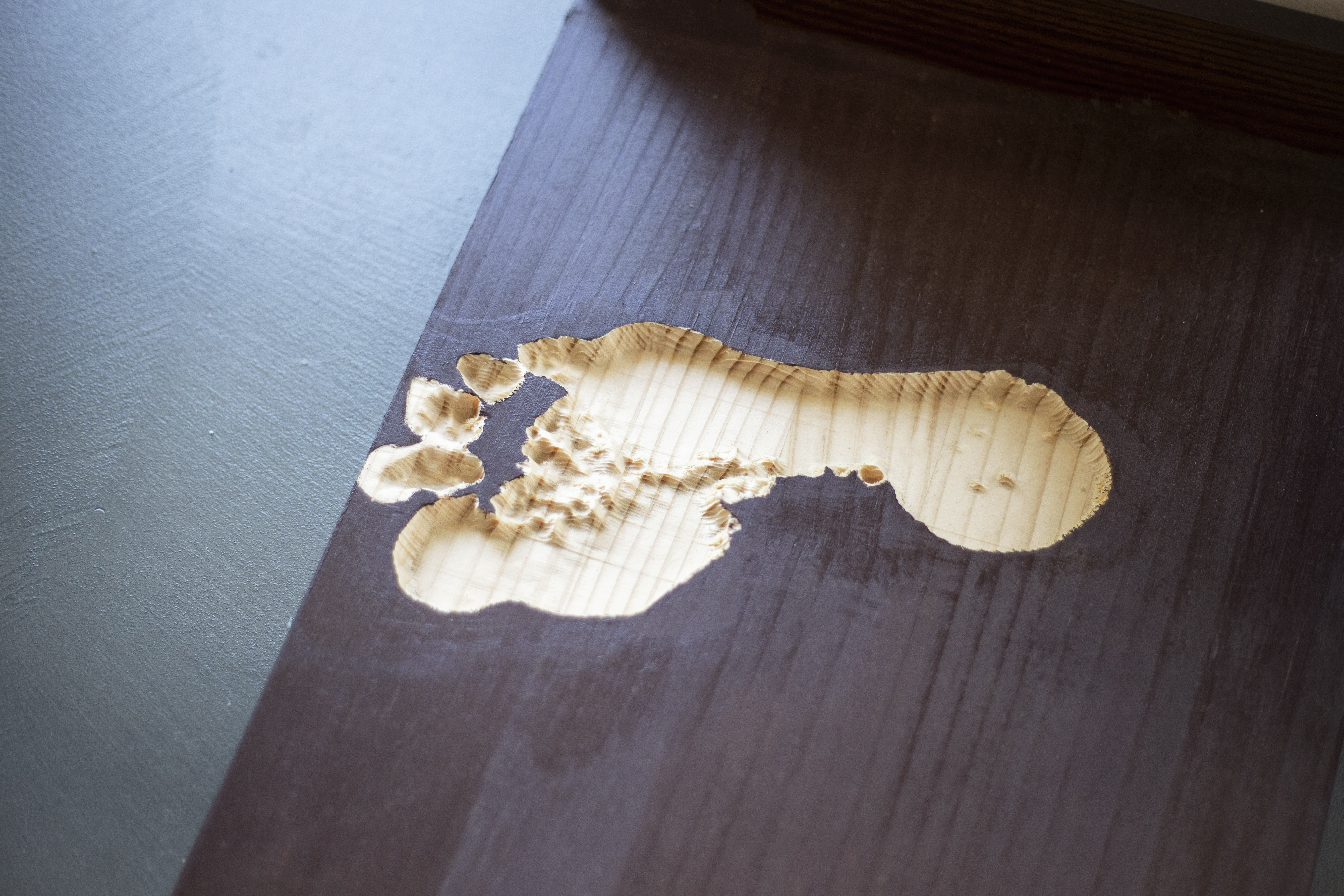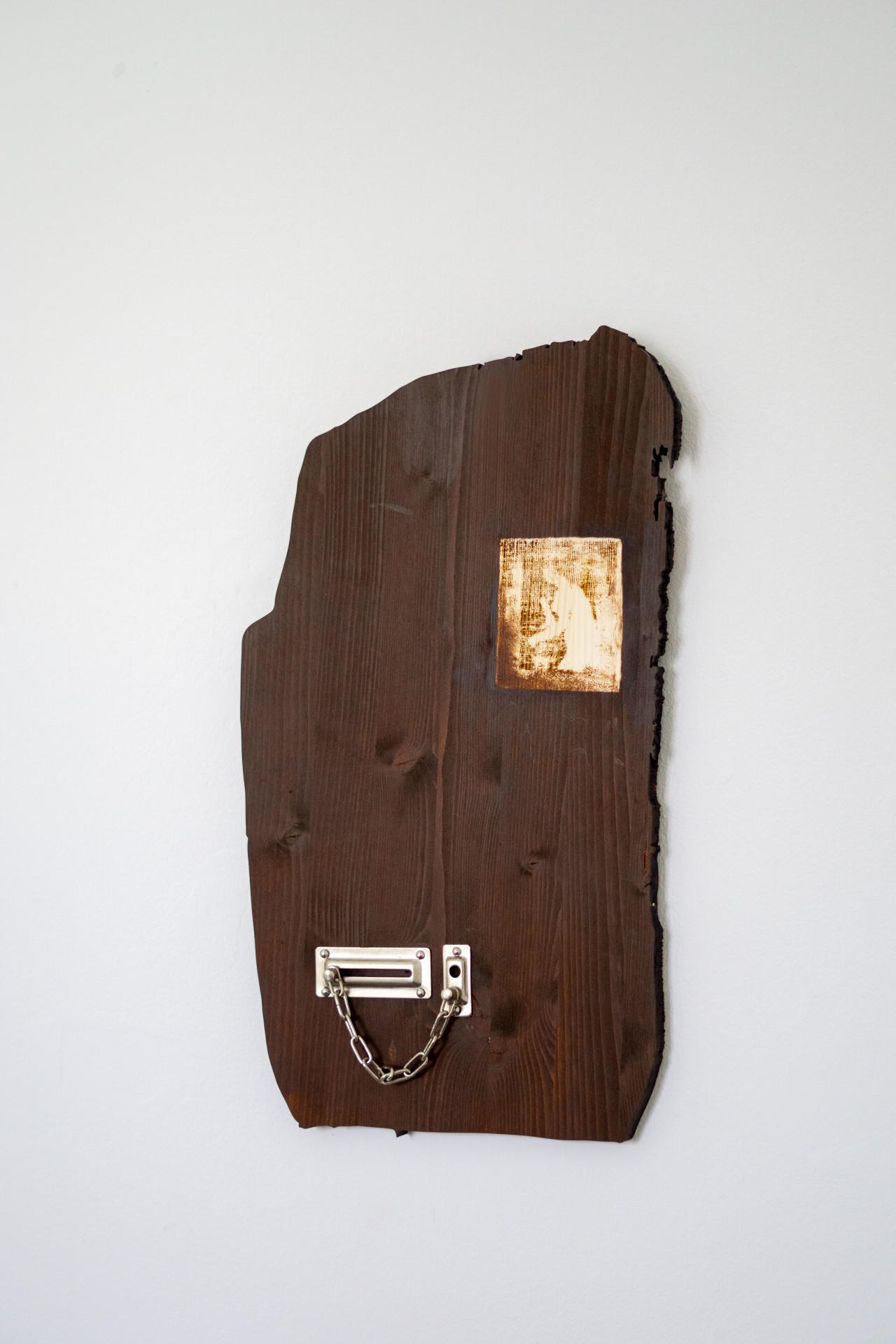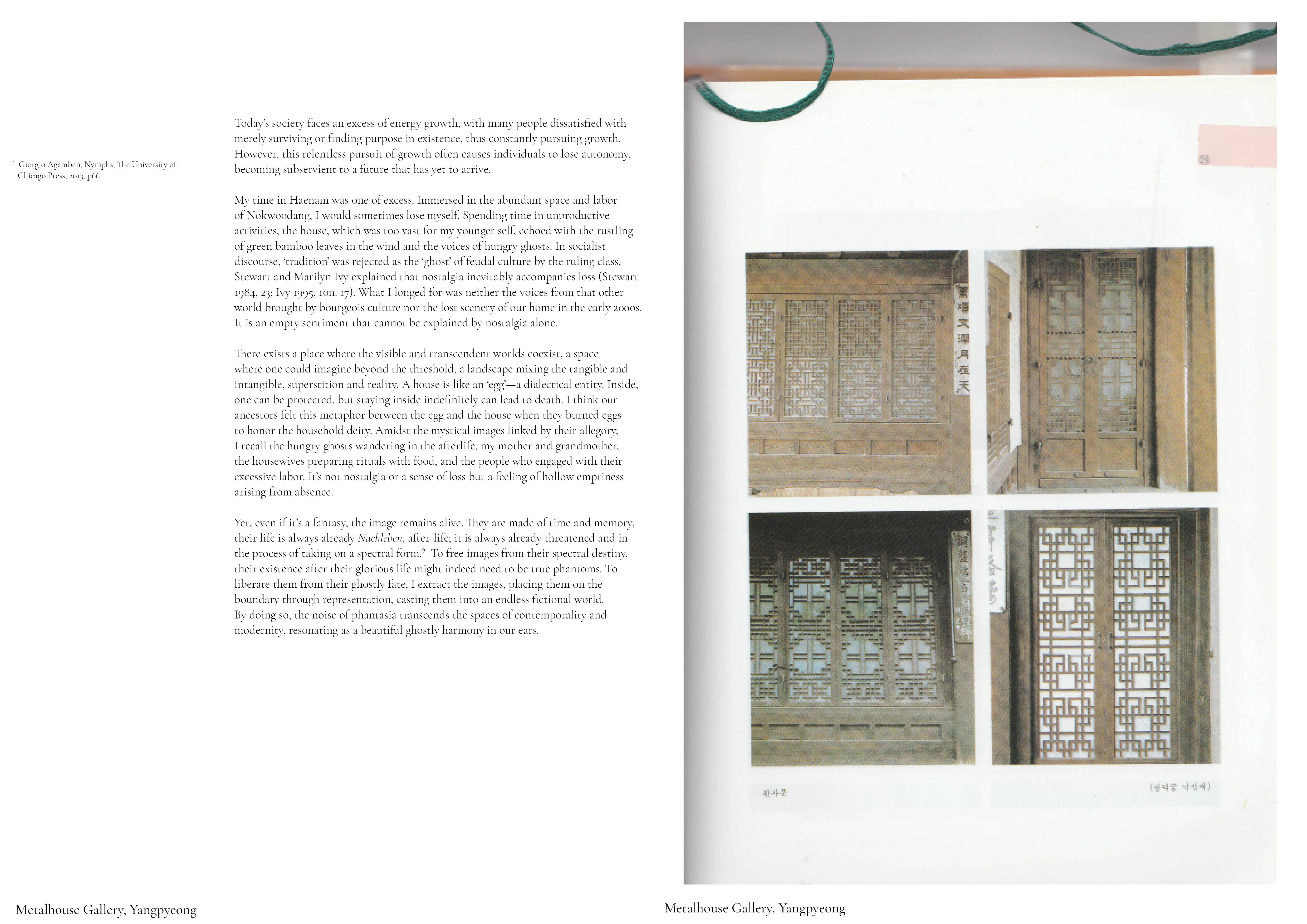Works > Of Hungry Ghosts, Housewives, and Untold Stories (2024)
Solo Exibition at Metal House Gallery,
Yangpyeong, South Korea
Yangpyeong, South Korea

Exhibition View <Of Hungry Ghosts, Housewives and untold Stories>
판타즈마의 궤적을 쫒는 판타즈마 (ENG below)
한주옥 (독립큐레이터)
케이 윤 (Kay Yoon)은 이야기꾼이다. 대부분의 시간을 읽고, 쓰며, 말하는 방식으로 이야기를 전한다. 언어의 체계를 벗어난 영역에서도 허밍 하듯 이야기를 이어간다. 지금 당신이 서 있는 곳, 무척이나 리드미컬한 음이나 혹은 요정의 작은 속삭임이 들린다면, 그것은 그가 근처에 있다는 신호일지 모른다. 문득 이 많은 이야기가 어디에서 시작되어 이루어졌는지 궁금해진 필자는 그 과정을 이해하기 위해 질문을 건넸다. 어떤 이는 기억과 상상으로 이야기를 만들어 내고, 또 다른 이들은 현실과 환상의 간극에서 논하지 않던가. 마침, 작가는 독일의 사회학자 프리가 하우크(Frigga Haug)의 저서 『여성의 성적화: 기억의 공동 작업』(Female Sexualization: A Collective Work of Memory)의 한 구절을 들려준다.
“만약 이야기가 기억된 것과 망각된 것의 경계를 나타낸다면, 소설로 이 경계를 지정하는 의도는 비가시성, 주변화, 배제와 같은 큰 문제뿐만 아니라, 왜곡, 재해석, 조작, 억압 같은 문제에도 주목하기 위함이다.”
‘기억’은 끈질기게 과거의 조각들을 되살려 순간적으로 또렷이 떠오르다가도, ‘망각’의 흐름 속에서 서서히 사라진다. 마치 끝없이 출렁이는 파도처럼, 이들은 맞닿았다가 이내 멀어지기를 반복한다. 작가는 이 순환에서 한 걸음 물러서서, 단순히 과거를 되살리는 데 그치지 않고 불협화음을 추적하고, 왜곡된 관계를 조명하며 망각 속에 묻힌 이야기들을 끌어낸다. 그 과정에서 현실과 이념, 타자와 주체의 관계 속에서 억압된 감정과 소외된 목소리들이 표면 위로 떠 오르며, 우리의 내면 깊숙이 각인된다. 그리고 이러한 사유는 이번 전시 《배고픈 망령, 주부, 그리고 끝나지 않는 이야기들》에서 작가의 시각적, 촉각적 장치를 앞세운 수행, 언어, 몸짓이 뒤섞인 형태로 구체화되며, 감각하고 추적할 수 있는 기회로 이어진다. 전시 타이틀에 등장하는 ‘망령’, ‘주부’, 그리고 ‘끝나지 않는 이야기’처럼, 작가는 마치 눈앞에서 형태가 드러날 듯하다가도 이내 자취를 감추는 존재로 자신을 설정한다. 그리고 이들로부터 이어받은 미지의 힘을 통해 메신저가 되어, 이야기를 전한다. 그러니 이제, 전시 ‘배고픈 망령, 주부, 그리고 끝나지 않는 이야기들’에 귀 기울여 보자.
먼저, 작가는 이번 전시 공간인 메탈하우스 갤러리의 동선과 구조에서 어린 시절 거주했던 녹우당(綠雨堂) 고택과의 유사성을 발견하고, 이를 전시의 구성에 반영한다. 가령 'ㅁ' 자형 구조에 맞춰 배치된 6점의 작품은 작가가 주목하는 경계인 문간방(threshold)을 넘어 마주하는 생동하는 장소로 변모하며, 관객을 이야기 속으로 끌어들인다. 즉, 경계에 대한 작가의 시선은 물질과 가상이 교차하는 장면으로 드러나 각각의 작품은 자연스럽게 전시의 흐름을 주도해 나간다.
“우리가 있는 곳을 이해하기 위해선 다른 곳(elsewhere)을 상상 할 수 있어야 해.
기억은 하나의 방. 문을 넘어가 보자”
기억은 하나의 방. 문을 넘어가 보자”
주문(柱門)을 넘는 순간, 물리적 경계를 넘어 새로운 차원에 접속하게 된다. 바닥에 설치된 작품 <Threshold (문간방)>(2024) 표면에는 무형의 경험과 뒤섞인 기억이 하나의 흔적으로 각인되어 있다. 작가는 '문지방'의 전통적 의미를 조각과 설치로 재해석하여, 관객이 직접 신체적으로 체험할 수 있는 공간으로 변모시킨다. 따라서 작품은 새로운 경험을 시작하는 입구이자 통로로 기능하며, 관객은 잊혀진 기억의 잔해가 요동치고, 미세한 소리가 감각을 일깨우는 능동적 장을 통과하게 된다. 복도를 따라 마주하는 작품 <두 번째 정류장- 다성적인 표상들 (Zweite Haltestelle: représentations polyphoniques)>(2024)은 장방형의 교자상(交子床)을 두 개씩 짝지어 위아래로 포개어 탑처럼 쌓아 올린 설치 작품이다. 오랜 시간 국외에서 생활한 작가에게 유럽과 한국의 식탁은 문화적 교차와 시간 및 경험의 축적을 담는 은유적 오브제가 된다. 사포로 연마되어 마모된 식탁과 기능을 다한 수저, 젓가락, 열쇠의 잠금장치와 같은 사물은 다소 무의미한 미감을 지니지만 작가의 무의식적 발로가 담긴 기념비적 형상으로 자리한다.
한편, 작가가 전작들에서부터 지속해 온 주제인 (비)물리적 경계를 넘어서려는 시도로서, 공기와 진동 같은 매질을 경유하거나, 비언어적 표명을 통한 수행에 접근해 왔음을 상기할 필요가 있다. 이러한 과정은 제의적 성격의 퍼포먼스와 다양한 오브제로 구성된 설치를 통해 공간의 위계를 전복하고 개념적 연쇄를 촉발하며, 작가의 시선이 교차하는 탐색의 장으로 제시된다. 작품 <Nightmare: A Mouth is A House (악몽: 입은 집이다)>(2024) 와 <Objects are closer than they might seem (사물은 보이는 것보다 가까이에 있다)>(2024)는 이러한 사유를 환기하며 감각적 여정의 서막을 열듯 하나의 공간에서 다층적인 경험을 유도한다. 사이드미러에 새겨진 문구를 제목으로 차용한 <Objects are closer than they might seem (사물은 보이는 것보다 가까이에 있다)>는 물리적 현실과 인식 사이의 모호함을 드러내며, 사물이 단순히 눈에 보이는 것 이상의 의미를 지닌다는 점을 다시 한번 상기시킨다. 이러한 사유는 조상과 신에게 바치는 음식과 제사 도구 등 주술적 의미를 지닌 요소들이 최소한의 형태로 배치된 설치에, 퍼포먼스 ‘망령 교향곡’이 개입하며 이성과 비이성, 재회와 상실, 현실과 가상을 가로지르는 무형과 유형의 메타포로 완성된다. 이로써 하나의 발화에서 시작한 정령, 주부, 이야기들은 각기 다른 감각을 매개해 인간으로서 겪는 본질적인 고민을 구체적으로 엮어간다.
마지막으로 작가는 작은 방에 배치한 작품 <A Woman Who Opens The Door: Juliana Korponajova (문을 여는 여인: 율리아 코르포나요바)>(2024)를 통해 18세기 초 슬로바키아에서 비극적인 운명을 맞이한 인물을 소환한다. 역사적 사실과 지역 전설이 결합한 율리아 코르포나요바는 반란군을 위해 문을 열었다는 이유로 처형되어 백색 여인, 즉 유령으로 전해진다. 작가는 이러한 맥락에서 삶과 죽음, 개인의 역사와 집단의 기억이 어떻게 얽혀 있는지를 탐구하며 미지의 경계를 떠도는 유령의 존재에 작가 자신의 해석을 결속한다. 기억을 더욱 뚜렷하게 붙잡기 위해 작가는 망령의 역할과 서사의 흔적을 추적한다. 비록 실체가 없는 허상뿐일지라도, 정령을 매개하는 상상의 영역 그리고 묵혀온 기억, 즉 상상으로 기억하는 이미지와 소리를 끌어낸다. 이러한 과정은 작가로서의 고민, 유령처럼 살아가는 본질, 실존에 대한 깊은 성찰이 뒤엉켜 있을 것이다. 이번 전시에는 6점의 신작과 퍼포먼스가 짜임새 있게 상호 연결되어 부피를 키우듯 전시장에 자리한다. 그리고 그 자체로 하나의 작품이 된다. 다시 말해 전시를 이루는 주체들이 각자의 개별적인 이야기로 정동하며, 동시다발적으로 존재하는 것이다. 그리고 그사이를 횡단하는 망령, 판타즈마(phantasma)의 궤적을 쫒는 판타즈마, 이야기꾼을 발견할 수 있을 것이다.

Second Stop - Polyphonic Representation (Zweite Haltestelle: représentations polyphoniques), 2024, gyoja table, ritual spoon, key lock and key, 90 x 75 x 210 cm

Detail view of <Second Stop - Polyphonic Representation (Zweite Haltestelle: représentations polyphoniques)>

Detail view of <Second Stop - Polyphonic Representation (Zweite Haltestelle: représentations polyphoniques)>

Gopulee: Ritual to release grief, 2024, Site-specific installation, Cotton, Variable Dimension

Scar, 2024, Cooper, 18.5 x 23 cm

Threshold (문간방), 2024, Gyoja Tables, 187 x 30 cm

Detail view of <Threshold (문간방)>

A Wall Whispers The Promise Of Reunion, 2024, Cooper Plate, A Lock from the Bridge of Love in Kosice, 97 x 35 cm

Nightmare: A Mouth Is A House (part 2) , 2024, blankets and pillows of recently deceased people, tin coated table, red beans and paper cups

Detailed view of <Nightmare: A Mouth Is A House (part2)>

Detail view of <Threshold (문간방)>

Nightmare: A Mouth Is A House (part 1), 2024, side mirrors, gyoja table legs, stainless steel

Detail view of <Nightmare: A Mouth Is A House (part1)>

Detail view of <Nightmare: A Mouth Is A House (part1)>

Exhibition View <Of Hungry Ghosts, Housewives and untold Stories>

Objects are closers than they might seem (사물은 보이는 것 보다 가까이 있다), 2024, Gyoja tables, stainless steel bowls, red beans, violin bow, acrylic chair, 340 x 20 cm

Details of <Objects are closers than they might seem (사물은 보이는 것 보다 가까이 있다)>

Details of <Objects are closers than they might seem (사물은 보이는 것 보다 가까이 있다)>

Details of <Objects are closers than they might seem (사물은 보이는 것 보다 가까이 있다)>

A Woman Who Opens The Door: Juliana Korponajova, 2024, Lacquered Wooden Plate, Door Lock, 33 x 52 cm

Exhibition View <Of Hungry Ghosts, Housewives and untold Stories>


With the Steps of the Ghostly Matters, 2024, Site-specific installation, tin coated trays, red beans, blankets of recently deceased people, bells and steel

Detail view of <With the Steps of the Ghostly Matters (2024)>

The Window where the Wind Carries the Han(恨), 2024, cotton, silk, gyoja table, 90 x 70 cm

A booklet made in a collaboration with Muon studio, graphic designer: Minju Park
Phantasma Chasing the Trajectory of a Phantasma
Joo-ok Han (Independent Curator)
Kay Yoon is an enigmatic storyteller, whose narratives permeate the air like a gentle hum, transcending the boundaries of language. Her stories unfold through various mediums—reading, writing, and speaking—yet persist beyond these conventional forms. One might discern her presence through a rhythmic cadence or the faint whisper of an ethereal being. Intrigued by the genesis and evolution of these tales, I posed several questions to unravel her creative process.
Some artists weave stories from the tapestry of memories and imagination, while others navigate the liminal space between reality and fantasy. In response to my inquiry, the artist shared an illuminating passage from German sociologist Frigga Haug's seminal work, "Female Sexualization: A Collective Work of Memory":
If "the margins of the story mark a border between the remembered and the forgotten: (Haug et al. 1987:68), my use of fiction to designate this border intends to call attention to both the broader issues of invisibility, marginality, and exclusion, and also to the "twist[s] and turn[s], reinterpret[ations] and falsify[cations], forget[tings] and repress[ings] [of] events" (ibid,:40)
Memory, in its persistence, resurrects fragments of the past, briefly illuminating them with startling clarity before they recede into the ebb and flow of forgetfulness. Like undulating waves, memory and oblivion touch, separate, and resurface in an endless cycle. Within this flux, Kay Yoon adopts a contemplative stance—not merely to resuscitate the past, but to scrutinize the dissonances of the present. Her work illuminates distorted relationships and excavates narratives gradually disappearing into obscurity. Through this process, repressed emotions and silenced voices emerge from the complex interplay between reality and ideology, self and other, leaving an indelible imprint on our collective consciousness.
This profound reflection materializes in the exhibition <Of Hungry Ghosts, Housewives and Untold Stories>, where these themes are rendered tangible through visual and tactile objects, interwoven with gestures and language that coalesce into sound and movement. Echoing the 'ghosts,' 'housewives,' and 'untold stories' of the title, Yoon manifests as an elusive presence—seemingly within reach, yet quick to vanish. Empowered by an ineffable force inherited from these spectral entities, she assumes the role of a messenger, bearing their narratives forward.
The artist's keen eye discerned a striking resemblance between the layout of the Metal House Gallery and Nokwoodang (綠雨堂), the traditional dwelling of her childhood. This architectural parallel informs the exhibition's composition, with six works arranged to mirror the gallery's square configuration. These pieces transform into dynamic spaces representing thresholds—the liminal boundaries that captivate the artist—inviting the audience into the narrative. In this way, her exploration of boundaries manifests through scenes where material and virtual realms intersect, each piece organically guiding the exhibition's flow.
"We need to understand where we are in order to imagine living elsewhere. Memory is a room, let's cross the door."
(An excerpt of the artist's reading performance)
The act of crossing the threshold transcends physical boundaries, ushering one into a new dimension. The floor installation Threshold (문간방) (2024) bears the imprint of memories intermingled with intangible experiences. Yoon reinterprets the traditional concept of a threshold through sculpture and installation, transforming it into a space for audience engagement. Thus, the work functions as both portal and passageway, guiding viewers through an active space where dormant memories stir and faint sounds awaken the senses.
One encounters Second Stop – Polyphonic Representations (Zweite Haltestelle: représentations polyphoniques) (2024) along the corridor—an installation featuring two rectangular gyoja tables stacked vertically. For the artist, who spent years abroad, dining tables from both Europe and Korea become metaphorical objects encapsulating cultural intersections, temporal accumulation, and layered experiences. The weathered tables, smoothed by sandpaper, along with objects like spoons, chopsticks, and a key's locking mechanism, possess a deceptively mundane aesthetic yet assume monumental form, imbued with the artist's subconscious expression.
It's crucial to note that in her previous works, the artist has consistently explored the theme of transcending (non-)physical boundaries, whether by navigating mediums like air and vibration or approaching performance through non-verbal expressions. Through installations composed of diverse objects and ritualistic performances, these processes subvert spatial hierarchies, catalyzing conceptual links and presenting a field of exploration where the artist's gaze converges. Works such as Nightmare: A Mouth is A House (2024) and Objects are Closer Than They Might Seem (2024) evoke this contemplation, culminating in a multilayered sensory experience. Borrowing its title from the cautionary phrase on car side mirrors, Objects are Closer Than They Might Seem exposes the ambiguity between physical reality and perception, reaffirming that objects harbor meanings beyond their visible form. This line of inquiry culminates in installations where ritual elements, like offerings and ceremonial tools, are arranged in their most elemental forms. The performance “A Symphony of Ghostly Matters” weaves together metaphors of the tangible and intangible, traversing boundaries between reason and unreason, reunion and loss, reality and the virtual.
In the exhibition's denouement, the artist presents A Woman Who Opens The Door: Juliana Korponajova (2024), summoning a figure who met a tragic fate in early 18th-century Slovakia. Juliana Korponajova, executed for opening the door to rebels, became known as the "White Lady"—a spectral presence. In this context, the artist explores the intricate interplay of life and death, individual histories, and collective memories, binding her own interpretation to the wandering ghost. To grasp memory more vividly, the artist traces the role of the ghost and the vestiges of narrative. Even if it is merely an illusion without substance, she excavates the imagined realm that mediates between spirit and long-forgotten memories—the images and sounds remembered through imagination. This process intertwines the artist's reflections on her own existential concerns, living like a ghost, and a profound contemplation of existence itself.
The exhibition showcases six new works, accompanied by a performance, intricately connected to suffuse the space like a burgeoning presence, coalescing into a singular, cohesive work. In essence, the elements comprising the exhibition move with their individual narratives, coexisting simultaneously. And within that space, one may encounter the wandering ghost, the phantasma chasing the trajectory of a phantasma—the storyteller herself.
Text텍스트 : Joook Han 한주옥
Performers퍼포머: Kay Yoon 케이 윤, Johannes Farfsing 요하네스 파프싱
Design디자인: Muon Studio 뮤온 스튜디오 / Minju Park 박민주
Styling의상 : Minsun Kim 김민선
Video영상 : Ahrin Jung 정아린
Photo사진 : Junghwa Jeong 정정화
Pansori Composer 작창가: Sol Park 박솔
Artistic Advisory 예술 자문: Teresa Retzer 테레사 레처
Research Advisory 리서치 자문:
Seolha Park 박설하 (Korean Shamanism)
Dr. Lukáš Šutor 닥터 루카스 슈터 (Slovak Mythology and Literature)
Proofreading교정 : Zakirah Rabaney 자키라 라바네이
Sound 음향: Johannes Farfsing 요하네스 파프싱



